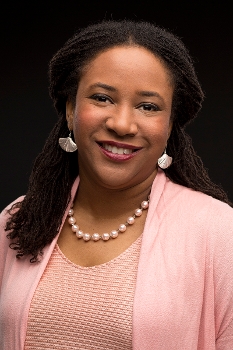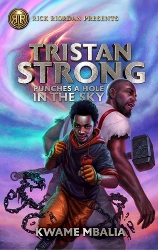Ebony Elizabeth Thomas on Magic, the Imagination Gap and "The Dark Fantastic"
A lack of diversity in children's literature and media, especially in fantasy, has created an "imagination gap," according to Ebony Elizabeth Thomas.
 Ebony Elizabeth Thomas wanted magic, but her mother warned it was not for her, or those like her. Working class black girls from Detroit needed to keep themselves firmly grounded in reality, staying out of trouble, not living in imaginary worlds where characters seek it out.
Ebony Elizabeth Thomas wanted magic, but her mother warned it was not for her, or those like her. Working class black girls from Detroit needed to keep themselves firmly grounded in reality, staying out of trouble, not living in imaginary worlds where characters seek it out.
But Thomas sought the magic anyway, mostly in the pages of books, where she found safety and hope from the real world in the “realm of the fantastic.” It became her personal passion and, later, a large part of her professional life as a teacher, writer, and now college professor with an expertise in diversity in children’s literature, youth media, and fan studies.
What she came to find along this journey was not only the well-documented lack of diversity in children’s literature but a corresponding lack of imagination, an “imagination gap” as she describes it.
“This imagination gap is caused in part by the lack of diversity in childhood and teen life depicted in books, television and films,” Thomas writes in the introduction to her forthcoming book, The Dark Fantastic: Race and the Imagination from Harry Potter to the Hunger Games. "When youth grow up without seeing diverse images in the mirrors, windows, and doors of children’s and young adult literature, they are confined to single stories about the world around them and, ultimately, the development of their imaginations is affected.”
 Thomas—who will be a keynote speaker at SLJ’s Leadership Basecamp at Rutgers University in New Jersey on May 3—believes that gap is tightening now with what she called “the fantastic turn” in movies and television thanks to Black Panther, Luke Cage, and others. But, anecdotally, young people still center their written stories around white characters, especially when it comes to fantasy. (Cicely Lewis writes about this very subject in her second Read Woke column.)
Thomas—who will be a keynote speaker at SLJ’s Leadership Basecamp at Rutgers University in New Jersey on May 3—believes that gap is tightening now with what she called “the fantastic turn” in movies and television thanks to Black Panther, Luke Cage, and others. But, anecdotally, young people still center their written stories around white characters, especially when it comes to fantasy. (Cicely Lewis writes about this very subject in her second Read Woke column.)
Thomas was the same way as a 9-year-old writing her first fictional character—Esther, a blonde Jewish girl, who was an amalgamation of her favorite writer Judy Blume, the All-of-a-Kind Family books, and the Sunday school story she heard about powerful Queen Esther.Thomas’s aunt asked why she didn’t write about a little black girl. It honestly hadn’t occurred to her.
“I had been so well socialized by my reading that by the time I reached an age to begin thinking about creating my own stories, I knew that people like me were not Barbie, we were Christie,” she says. “If we were included, we were people whose purpose in the story was to support the protagonist, or we were background characters who were potential cannon fodder. I knew I was not meant to be the protagonist in most stories across genres. From the literature we read in school to even the genre fiction.”
A few years later she would make a black girl the main character in her next attempt at fiction, but even that story didn’t dip into her favorite topic—fantasy, science fiction…the fantastic.
“If you think about the reading kids do over time by the time they are adults, they begin thinking about characters and narrative in ways that tend to be set,” says Thomas.
Even when authors of color sit down to write stories with characters of color, they do not immediately think to write fantasy and fantasy writers do not inherently include characters of color.
“Either they don’t make the leap to writing characters of color or they don’t think characters of color should be in fantasy. Then if they do, they sort of paint by numbers,” she says. “Just by changing the race of the character but keeping the narrative the same that creates dissonance and it causes the reader to fall out of the suspension of disbelief.”
She does see progress and hope for the young generations, however.
“That’s changing in the digital age, the ways in which kids are restoring the text so they can see themselves in it.” Thomas says. “It just wouldn’t have occurred to me and most black people, or queer people my age. The book, the text was what it was in the pre-internet age. I do think the digital age opens up possibilities.”
While diversity remains an issue in children’s literature, there are many more titles featuring characters of color, including in fantasy.
 Thomas is looking forward to Tristan Strong Punches a Hole in the Sky by Kwame Mbalia, which is scheduled for publication in early 2020.
Thomas is looking forward to Tristan Strong Punches a Hole in the Sky by Kwame Mbalia, which is scheduled for publication in early 2020.
“Mbalia has taken the John Henry myth from Black American history and folklore and he has used that to create, from all accounts, tremendous middle grade fantasy,” she says.
 Right now, she recommends the alt-history fantasy Dactyl Hill Squad by Daniel José Older for middle grade and, for the middle grade to YA audience, Older’s “Shadowshaper” series and Dhonielle Clayton’s The Belles and The Everlasting Rose.
Right now, she recommends the alt-history fantasy Dactyl Hill Squad by Daniel José Older for middle grade and, for the middle grade to YA audience, Older’s “Shadowshaper” series and Dhonielle Clayton’s The Belles and The Everlasting Rose.
“I like it when the authors use a culture, do the kind of mythbuilding that you see in high fantasy, just like Tolkien drew on Anglo-Saxon and Norse mythology to build Middle Earth,” says Thomas. “Dhonielle Clayton dug into New Orleans culture and issues of beauty and colorism for her fantastic duology.”
Writing fantasy doesn’t mean an author can ignore history completely or be ignorant of culture and anything a reader might bring into the story.
“I respect authors like Tomi Adeyemi and Nnedi Okorafor who have written books for young readers that are based on Nigerian and Nigerian-American cultures, so you don’t have this problem of amalgamation,” she says. “You’re organically digging into extant myth and folklore and you are using that to build a fairytale, a fantasy, science fiction.”
Thomas is now following their example in a way, as she researches Black American myth and folklore for her current manuscript.
“I’m trying to write a Black American fantasy,” she says.
Having left little blonde Esther behind, Thomas is creating not only a black protagonist but one who will live in the magic world of Thomas’ imagination.
RELATED
The job outlook in 2030: Librarians will be in demand
The job outlook in 2030: Librarians will be in demand
ALREADY A SUBSCRIBER? LOG IN
We are currently offering this content for free. Sign up now to activate your personal profile, where you can save articles for future viewing






Add Comment :-
Comment Policy:
Comment should not be empty !!!
Tracey Y Smith
Great article! Will have to check out these books.Posted : Apr 18, 2019 02:03